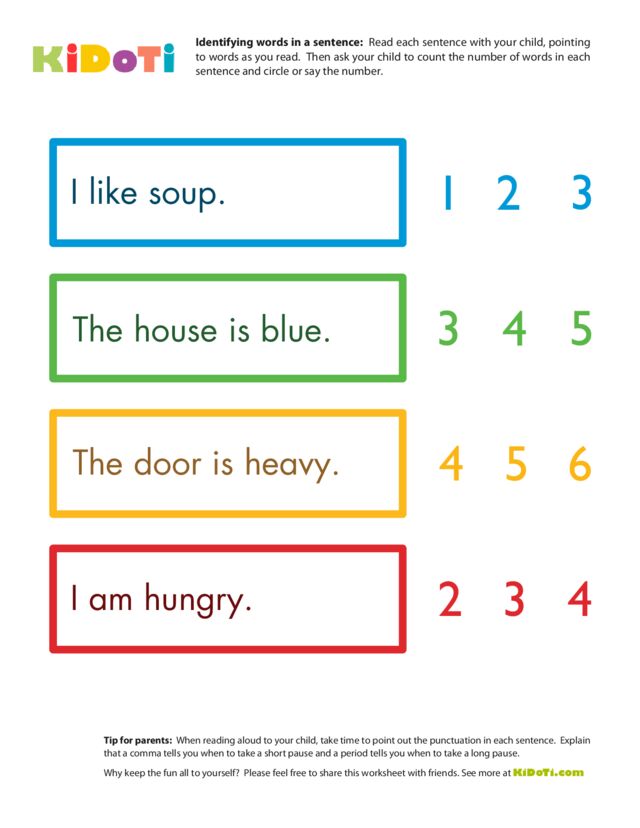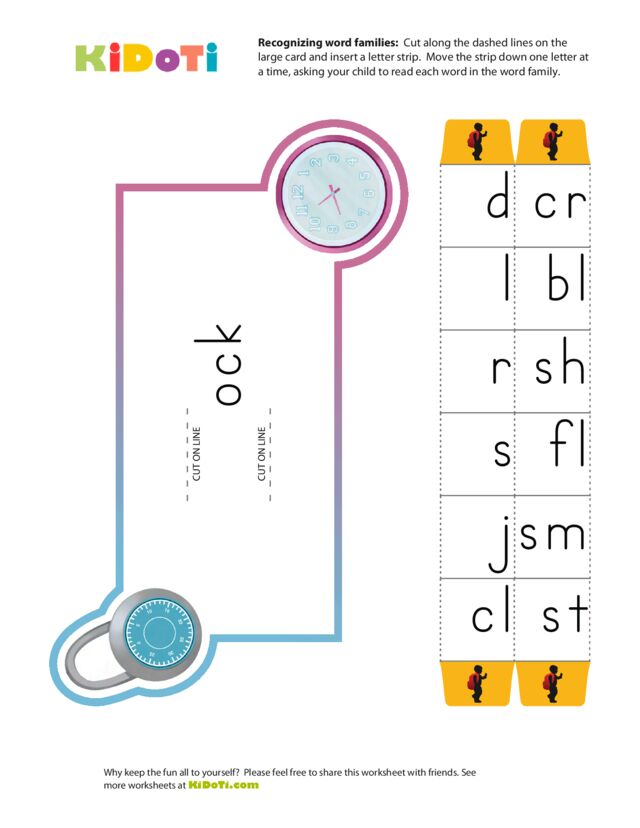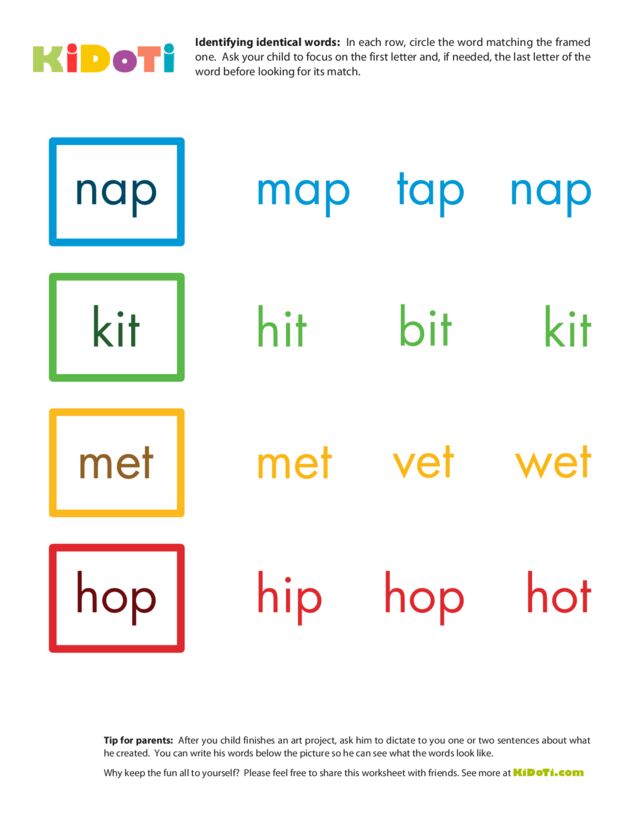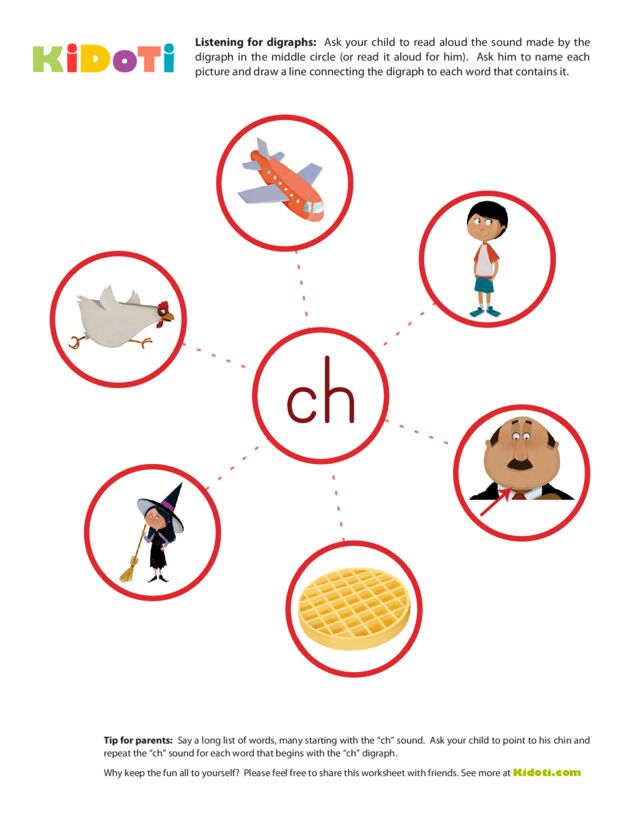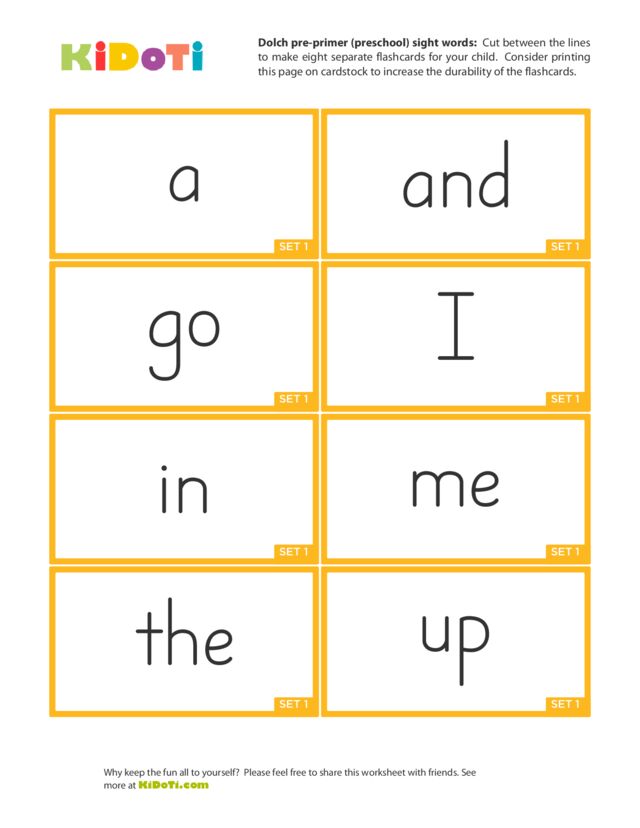Learning to read is an exciting and fundamental part of any early childhood education program. Before children become fluent readers, they need to master a set of basic pre-reading skills such as identifying the sound(s) of each letter and how certain letters combine to form specific words. The worksheets in this section will guide your child through a series of critical pre-reading activities to ensure he gains a solid foundation of skills.
Words in a Sentence
Word Families
Similar Words
Digraphs
Digraphs is a phonics term that refers to two or more letters that make a…
Dolch Sight Words
Sight words are words that appear frequently in written text or words that do not…
The importance of pre-reading skills
It goes without saying that children must be aware of letters and words before they can learn to read. Children hear language all around them and even see words printed in books and on signs, but they do not always make the connection that a group of letters form a word that has meaning. To become confident, successful readers, children need a strong foundation of pre-reading skills.
A large component of pre-reading activities is developing what educators refer to as “phonemic awareness.” Phonemic awareness is the ability to hear and isolate the specific sounds (called phonemes) in a word. When a child has strong phonemic awareness skills, he can separate words into their individual sounds, which means that he will be able to spell words more easily. He will also be able to read words by assigning the correct sounds to the letters that he sees and blend the sounds together to form the word.
The pre-reading worksheets on this page begin by introducing children to basic activities such as matching words that begin with the same sound and matching letters with the sounds they make. These worksheets also include important opportunities to practice identifying rhyming word pairs, another important pre-reading skill. These activities provide important opportunities to develop strong phonemic awareness.
Once children are beginning to read, learning sight words and recognizing word families contributes greatly to reading comfort and fluency. Flashcards for sight words and word family sliders are excellent tools for practicing reading and learning new words. There is additional word and reading practice with the worksheets featuring sight word sentences and the sight word bingo game. Learning sight words can become somewhat tedious without finding new activities and games to spice up the practice, so these worksheets will be valuable for the practice as well as for the added variety they provide.
Tips for using the pre-reading skills worksheets
Pre-reading worksheets that focus on the sounds letters make are an easy way to help your child improve his phonemic awareness skills through practice listening for sounds in words.
As children start developing general phonemic awareness, they become aware of the different parts of words (called syllables). The Identifying Syllables worksheets help children with this skill. As their phonemic awareness skills improve, children become able to hear the ending sounds in words and identify rhyming words.
When working on the Identifying Syllables worksheets, begin by letting your child know that words are made of several parts, called syllables. Give your child a few examples, using simple, compound words such as cupcake, sunshine or baseball. Clap on each segment of the word and ask your child to try this, also. He will now be ready to tackle the Identifying Syllables worksheets. As always, begin with the easiest ones and move on to the more difficult sheets. Some children may struggle to properly identify a one-syllable word, since the tendency may be to stretch the word into two syllables by saying cuh-at, for example, instead of cat. To help your child, be sure to say each word clearly but quickly so that he does not mistakenly hear extra, unintended syllables.
Next I would introduce your child to the pre-reading skills worksheets that focus on Identifying Rhyming Words. Glance over the worksheet quickly to make sure that you and your child are labeling the pictures correctly so that the words rhyme. For example, cane rhymes with mane, but does not rhyme with lion, so it is important to ensure that your child has the proper name for each picture. Asking your child to say aloud the names of all of the pictures will help him hear the ending sounds.
Finally, I would direct your child to the pre-reading skills worksheets that focus on the beginning sounds in words. At first your child will only need to listen to and match the sounds at the beginning of the words. Later, he will be asked to know which letter makes that sound. The matching games sheets and the memory games sheets make phonemic awareness practice fun.
The next level of difficulty comes with the word family worksheets. Once children know the sound that each letter makes, they are ready to put those sounds together to form words. When they learn a particular word family, they can read many words quickly by substituting the beginning consonant sound of the word. These worksheets also give children the chance to move a strip of letters through the card, so practice becomes an interesting activity. Point out to your child that by moving the letter strip through the card he creates words that all rhyme. Your child can create silly rhyming words by swapping the letter strips from other word family cards. The sillier the words, the better, since it helps to keep children engaged.
Finally, introduce the Dolch sight words with the flashcards, showing your child just a few new words at a time. Repeated exposure to these words will help your child commit them to memory. The sight word bingo game and the sight word sentences can help make practice more fun and less of a chore.
You can also try creating some other games with the sight word flashcards. For example, fan out several flashcards in your hand as if you were holding playing cards. Let your child pick a card and read it. Or show him two or three cards, then place them face down and mix them up while he watches and let him try to guess which word he is picking. You can also display the flashcards on a bulletin board or wall and rotate them as your child learns them. For practice, he can point to each word and read it as he walks by the display.
Additional ways to help your child develop strong pre-reading skills
- At every opportunity, call you child’s attention to the sounds in words. For example, play a game where you say pairs of words and ask your child if the words are the same or if they are different. Then say pairs of words, repeating some words twice or saying two different, but somewhat similar words (flat and pat, for instance). This is a fun game to play while riding in the car and requires strong phonemic awareness skills as your child will need to listen carefully to each sound in the words you say to determine whether or not the starting sounds match.
- Start saying a string of rhyming words and ask your child to add some more words to it. See how long your list can grow. Or try saying a sentence where most of the words begin with the same sound and see if your child can guess which sound you are highlighting. An example might be: Come catch this can of creamed corn. Creating a long string of words that all begin with the same initial sound requires well-formed phonemic awareness skills, so challenge your child to follow your example and create a long sentence of his own.
- Suggest a letter sound and then challenge your child to name as many words as he can think of that begin with that sound. For example, you can suggest the letter N sound and then count to 20 while your child races to name as many words that begin with the letter N sound as he can. This is an easy way to practice phonemic awareness skills in short bursts of time, such as when waiting in line at the grocery or when putting on shoes to go outside.
- Make a habit of pointing to words as you read them, whether they are in a book or on a street sign. As your child begins to associate printed letters with specific words, he will become increasingly curious about what the words that he sees all mean, and this will fuel his interest to learn to read. This will also help your child add more sight words to his sight word vocabulary.
